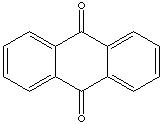| ANTHRAQUINONE | ||
|
PRODUCT IDENTIFICATION |
||
| CAS NO | 84-65-1 |
|
| EINECS NO. | 201-549-0 | |
| FORMULA | C14H8O2 | |
| MOL WT. | 208.22 | |
| H.S. CODE | 2914.61 | |
| TOXICITY | Oral rat LD50: 15 gr/kg | |
| SYNONYMS | 9,10-Anthracenedione; Anthradione; Hoelite; Morkit; | |
| 9,10-dihydro-9,10-dioxo- Anthracene; 9,10-Dioxoanthracene; 9,10-Anthrachinon; Corbit; Anthracene-9,10-quinone; 9,10-Anthraquinone; | ||
| SMILES |
|
|
|
CLASSIFICATION |
|
|
|
PHYSICAL AND CHEMICAL PROPERTIES |
||
| PHYSICAL STATE | yellow green solid | |
| MELTING POINT | 284 - 286 C | |
| BOILING POINT | 379 - 381 C | |
| SPECIFIC GRAVITY | 1.44 | |
| SOLUBILITY IN WATER | Insoluble | |
| AUTOIGNITION | 650 C | |
| pH | ||
| VAPOR DENSITY | 7.16 | |
| NFPA RATINGS | Health: 0 Flammability: 1 Reactivity: - | |
| FLASH POINT |
185 C |
|
| STABILITY | Stable under ordinary conditions | |
|
GENERAL DESCRIPTION & APPLICATIONS |
||
| Anthraquinone, a polycyclic aromatic hydrocarbon containing two opposite carbonyl groups (C=O) at 9,10 position, is yellow or light gray to gray-green crystal powder; insoluble in water. , In nature, it occurs in plants (aloe, cascara sagrada, senna, and rhubarb), fungi, lichens, and insects as a parent material for coloring of yellow, orange, red, red-brown, or violet. It is commercially produced by several ways including by oxidation of anthracene with chromic acid, the condensation of benzene and phthalic anhydride, followed by dehydration for cyclization, and diene Diels-Alder reaction. Anthraquinone is the most important quinone derivative of anthracene as the parent substance of a large class of dyes and pigments. One of the oldest mordant dye, alizarin, is the anthraquinone derivative. Anthraquinone is a starting material for the production of coloring compounds, antioxidants, and polymerization inhibitors. Its derivatives are widely used as intermediates for dyes, pigments, photographic chemicals, and paints. Anthraquinone is used in paper industry as a catalyst to increase the pulp production yield and to improves the fiber strength through reduction reaction of cellulose to carboxylic acid. Natural anthraquinones have cathartic properties. Anthraquinones derivatives are also used in manufacturing drugs. Mitoxantrone, an antineoplastic is an example. | ||
| SALES SPECIFICATION | ||
|
APPEARANCE |
Light tan powder |
|
|
PURITY |
99.0 % min |
|
|
MELTING POINT |
283 C min |
|
|
ASH |
0.5 % max |
|
|
MOISTURE |
0.5 % max |
|
|
LOSS OF DRYING |
0.2 % max |
|
| TRANSPORTATION | ||
| PACKING |
25kgs, 50kgs, 600kgs in Bag |
|
| HAZARD CLASS | ||
| UN NO. | ||
| OTHER INFORMATION | ||
| Hazard Symbols: XI, Risk Phrases: 36/37/38 | ||
| PRICE INFORMATION | ||
